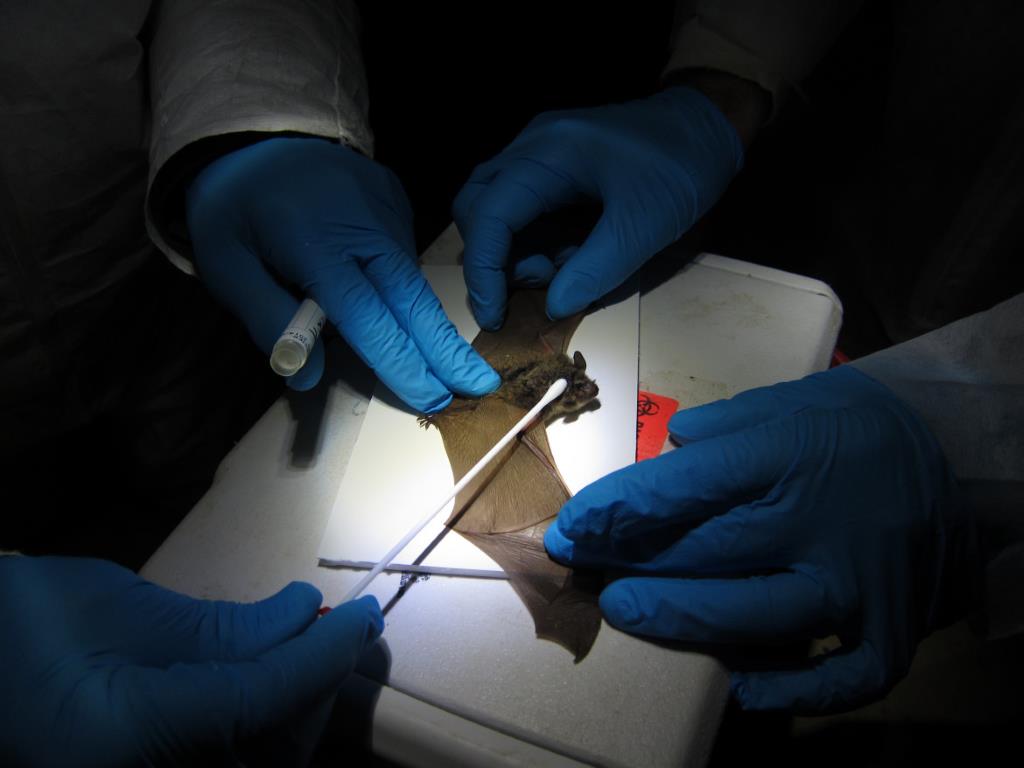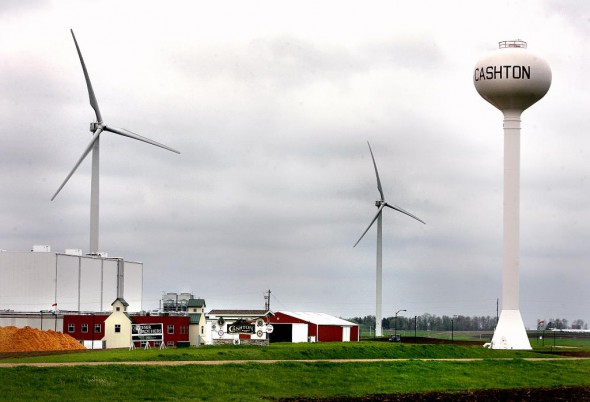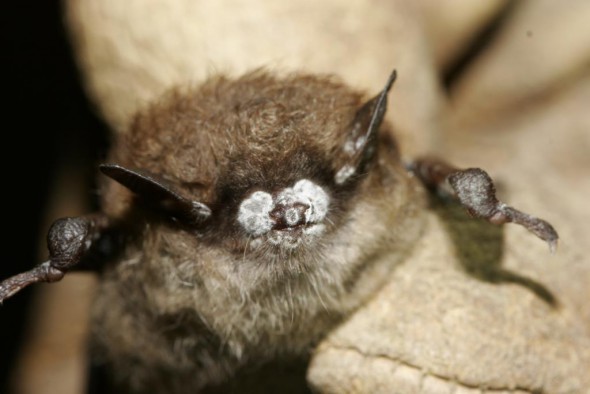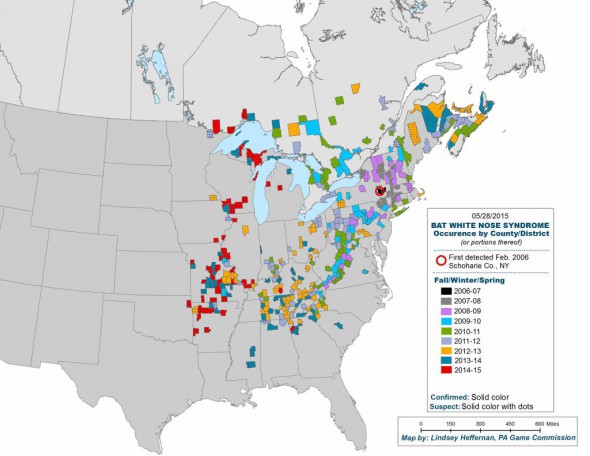Wind Turbines Threaten Bats Here
Study shows they kill about 1 million per year and Wisconsin has some of region's largest bat hibernation sites.

Illinois scientists swab a northern long-eared bat suspected of having white-nose syndrome in 2013. The U.S. Fish and Wildlife Service is considering exempting wind turbines from rules protecting the threatened bat species. Photo by Steve Taylor of the University of Illinois, via U.S. Fish and Wildlife Service.
The U.S. Fish and Wildlife Service is considering requests from the wind energy industry to exempt wind turbines in Wisconsin and nationwide from new rules to protect threatened bats, even as a fungal disease has killed millions of the creatures.
Because of the disease, white-nose syndrome, the federal agency listed the northern long-eared bat as threatened. The temporary rule to list the bat as threatened exempted some activities, but not wind energy generation. The agency is now considering a final rule, including potential exemptions for wind turbines.
The Fish and Wildlife Service said wind turbines cause a significant number of bat deaths. A 2013 study, cited in the Federal Register, found wind turbines nationwide killed 650,000 to 1.3 million bats in a year.
“You actually have dead bodies in hand,” Rick Amidon, a USFWS regional director in Minnesota, said of the giant turbines. He contrasted that with forestry and highway right-of-way work, which are exempted from the new rules because they kill and harm fewer bats.
Estimates through 2013 show white-nose syndrome has killed as many as 6.7 million bats since it was first discovered in 2006, according to the Fish and Wildlife Service. The agency said it expects the disease to spread and the number of deaths to grow.
In 2008 and 2009, a carcass survey conducted at the Blue Sky Green Field Project wind farm in Fond du Lac County estimated the bat fatality rate during the six-month study period at 41 bats per turbine.
Such fatalities are of special concern in Wisconsin where white-nose syndrome is spreading and threatening to dramatically reduce bat populations. The state Department of Natural Resources has found the disease itself or the fungus that causes the disease at 14 hibernation caves, or hibernacula.

These wind turbines, a joint venture between Organic Valley and Gundersen Lutheran Health System, loom over Organic Valley’s distribution center in Cashton, Wis. Photo by Peter Thomson of the La Crosse Tribune courtesy of the Wisconsin Center for Investigative Journalism.
Diseased bats have been found in Grant, Crawford, Richland, Door and Dane counties. The fungus has been discovered in Iowa, Dodge and Lafayette counties.
The disease was first seen in a Grant County mine in March 2014, and 70 percent of the bats there have since died – an indication of how deadly the disease can be. So far, that mine is the only location where bats have died in such large numbers in Wisconsin.
Wisconsin is home to several of the largest bat hibernation sites in the upper Midwest, with a population estimated at up to 500,000. The state’s four species of cave bats — all of which are threatened by white-nose syndrome — serve a crucial role by consuming insects that cost farmers nationwide billions of dollars a year.
Wind turbine operators and proponents argue that the disease is the primary threat to bats and that the turbines do not account for enough deaths to warrant stricter rules.
John Anderson, a senior director for the American Wind Energy Association, said it is neither fair nor effective for the Fish and Wildlife Service to put “a conservation burden on activities that are not having a significant effect,” Midwest Energy News, a non-profit energy news website, reported recently. “The wind industry is one of them.”
High-stakes mortality
But Amidon, with the Fish and Wildlife Service, said that some bat populations — such as northern long-eared — are so precarious that even the marginal additional deaths caused by wind turbines can become a factor in their survival.
“The bottom line,” Amidon said, “is that if you have a huge population decline, the bats that are remaining become very important.”
The northern long-eared bat, one of four cave bat species in Wisconsin, weighs only about .03 ounces and has been found in 37 states. It has been identified in 67 of the state’s hibernacula. Other than those caves and mines, however, the bat has no other refuges, according to the Fish and Wildlife Service, and a population analysis led the agency to conclude that the bat could face extinction if white-nose syndrome infected its major hibernacula.

Bat fatalities from wind turbines are of special concern because white-nose syndrome has already decimated populations across the country. The fungus was discovered among little brown bats in New York, like this one from 2008. Photo by Al Hicks.
The decision to list the bat species as endangered could force wind turbine operators in affected areas nationwide to spend about $610 million over the next 30 years, according to the American Wind Energy Association.
That cost would cover developing and maintaining a habitat conservation plan, which would show how the operator is going to minimize bat deaths. Such a plan would be required by the wildlife service before it issued an “incidental take” permit, allowing inadvertent killing of bats.
Brian Manthey, a spokesman for We Energies, which owns the Fond du Lac wind farm where the tests were conducted, said the utility must find a way to protect bats and birds while maximizing wind energy production. According to the American Wind Energy Association, Wisconsin’s 417 wind turbines provided 2.65 percent of all in-state electricity production in 2014, enough to power 148,000 homes. Manthey added that percentage is expected to grow.
Manthey said there is no doubt that the bat protections would be a “financial hit” for turbine operators.
“What would have to be weighed is how do we maximize the amount of energy with the least impact on bats and birds,” Manthey said.
Midwest plan proposed
In a related move, the Fish and Wildlife service is also taking suggestions for an environmental impact study on an eight-state plan to protect habitat for all bats and birds. The agency has scheduled a series of hearings, including a comment session in Madison on Tuesday.
In the study, the agency would consider the impact of exemptions which would protect operators of wind turbines from prosecution for incidental bat deaths and injuries.
The Wisconsin DNR has been working with the Fish and Wildlife Service on early drafts of the habitat conservation plan. DNR spokesman Bill Cosh said the federal agency is considering exempting wind farm development except in areas within a 20-mile radius around primary hibernacula, including the Bay City, Maiden Rock and Neda mines, along major rivers and within three miles of Great Lakes shorelines.
New wind projects in areas not covered by the habitat plan would need to seek individual incidental take permits from the Fish and Wildlife Service, Cosh said.

The highly deadly white-nose syndrome has spread rapidly since it was discovered in New York in 2006. The disease has killed millions of bats, including many in Wisconsin. Map by Lindsey Heffernan of the Pennsylvania Game Commission.
But Amidon said wind turbine operators have indicated they would prefer a blanket exemption.
In seeking exemption from the threatened species rule, the American Wind Energy Association has proposed adjusting turbine operations to reduce bat deaths. Based on the theory that bats do not fly in high winds, the association says that operators could prevent blades from turning until the wind reaches a certain speed, known as “cut-in speed.” During migration periods and during periods of low wind, bats are more active.
Manthey said the practice is the subject of a new study by WE Energies. According to the company, other studies have reported average reductions in bat mortality ranging from 36 to 89 percent using such curtailment practices.
Russ Benedict, a professor of biology at Central College in Pella, Iowa, estimated that changing the cut-in speed would cut bat mortality by 50 percent but only reduce energy production by 3 percent.
“If we are more careful about when we use wind turbines,” Benedict said, “we won’t have that big of an impact on energy production, but we can dramatically reduce bat mortalities.”
The Iowa Center for Public Affairs Journalism contributed to this report.
The nonprofit Wisconsin Center for Investigative Journalism (www.WisconsinWatch.org) collaborates with Wisconsin Public Radio, Wisconsin Public Television, other news media and the UW-Madison School of Journalism and Mass Communication. All works created, published, posted or disseminated by the Center do not necessarily reflect the views or opinions of UW-Madison or any of its affiliates.
-
Legislators Agree on Postpartum Medicaid Expansion
 Jan 22nd, 2025 by Hallie Claflin
Jan 22nd, 2025 by Hallie Claflin
-
Inferior Care Feared As Counties Privatize Nursing Homes
 Dec 15th, 2024 by Addie Costello
Dec 15th, 2024 by Addie Costello
-
Wisconsin Lacks Clear System for Tracking Police Caught Lying
 May 9th, 2024 by Jacob Resneck
May 9th, 2024 by Jacob Resneck




















Very interesting piece and food for thought. I think it’s essential that we expand the wind energy sector, but I guess all things, even good ones, have consequences.
Thank you for the well written report. I support as much large wind as WI can build since it produces energy in our state instead of importing it. This stresses the need for better siting of these turbines to limit wildlife damages. Bats eat their weight in insect prey on a nightly basis are a beneficial creature to have in our state.
For a comparison large lighted buildings kill millions of migratory birds annually. But we rarely see any questions in this area of concern. Feral cats kill thousands of birds annually and no clear plan is in place to deal with cats. Both of these cases have solutions.
This article does not quantify the numbers of wind turbines in Wisconsin and surrounding states. As it turns out, Wisconsin has fewer commercial wind turbines than any of its neighboring states. Notwithstanding the presence of bat hibernacula near several Wisconsin wind energy installations, the plain and simple fact is that fewer bats are killed in Wisconsin than in surrounding states. Iowa has nearly ten times the number of operating wind turbines as does Wisconsin, and Illinois has about five times more wind turbines. And the number of wind turbines operating in Wisconsin has not changed since 2012. Wind developers have given up on Wisconsin as a place to do business, so the “threat” posed by the commercial wind industry to bats that roost or hibernate in Wisconsin is not growing. It’s unfortunate that this article did not cite numbers that would help readers put the threat in perspective.
people talk of better siting of wind turbines( have heard that lie for almost 10 years now)….the problem is animals are still there. wind turbines in NJ and DE were found to kill 80 creatures per year….including a peregrine falcon….only 25 breeding pair in the state….and only 6 industrial wind turbines(imagine a 1000’s) Wind Turbines in California are the #1 killer of Golden Eagles an international protected raptor(Obama hyper-partisan government ignores the treaties and laws). Only migrants eagles from other state have kept them from being wiped out…but now more states are building….so GUESS WHAT HAPPENS….IGNORANT DO GOODERS? Most animal kill information is hidden or just ignored. The state of Massachusetts has published almost zero information on the kill rate from their many industrial turbines…can’t let facts get in the way of ideology….the head of DEP is a partner in the lawfirm making millions putting p the turbines) Pennsylvania found turbines on average killed 25 bats….with plans for 3000 wind turbines…that is 75000 dead bats PER YEAR on top of terrible white Nose Syndrome! Efficiency and conservation actually are more cost effective way to reduce CO2, require no land, no death to animals, no destruction of open space…the reason this isn’t pushed is Democrat cronies and power companies don’t make money from it!